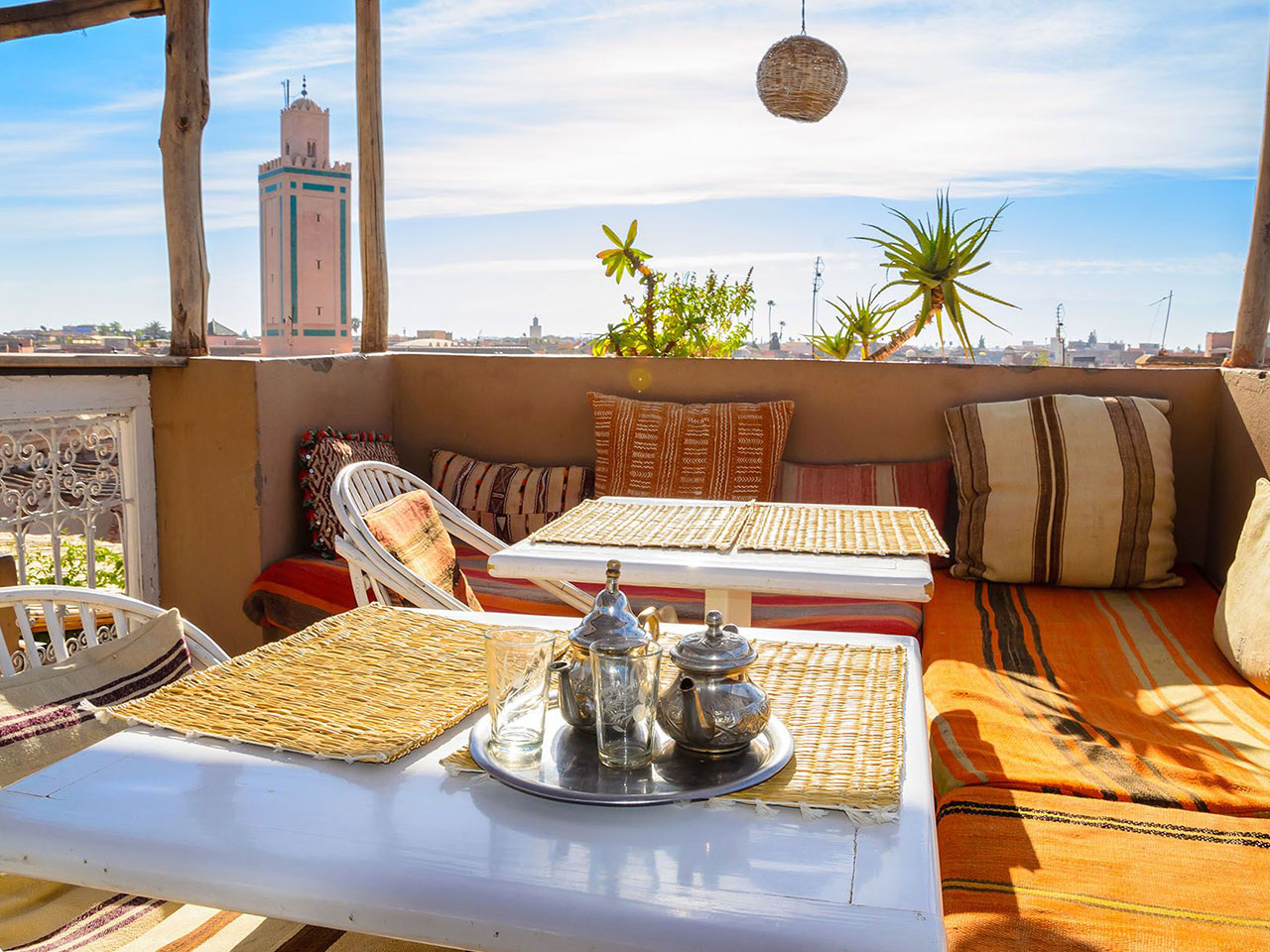Marrakesh tour
Hosting you is a delight
GLOBAL MOROCCO EXPLORATION DAY TOURS-MARRAKESH
Marrakesh The Pearl of the South
City with thousands of years of history behind it
Marrakesh is Morocco red pearl that always impress its visitors by the contrast it holds. The ochre of its walls, its bougainvillea covered exteriors, great bunches of palm trees, lavish greenery, snow-capped peaks of the high Atlas Mountains makes of Marrakesh a thriving, sun-soaked oasis.
Marrakesh is a city of legend, cultural, inspirer of artists, fashions and events. With its art galleries, festivals, and exhibitions, its luxurious palaces and glittering nightlife is a real marvel. It blends the treasures of its old age heritage with the vibrant energy of living cultures.
Absolutely, Marrakesh is a cherished experience. Many discoveries await you every time you return – and many returned never to leave.
Marrakesh is a city of thousand years of history. Five dynasties came and gone, each one leaving their permanent mark on its destiny. It was founded in 1062 by the Almoravids, whose greatest heritage was to bring water to the city by connecting spring waters in a clever system of wells and piping networks. Thanks to Almoravids, the city’s Palmeraies, its gardens and orchards become watered. Under their rule, Marrakesh became the capital of Morocco. The Almohads took the rein in the 12th century, refining irrigation systems, widening the city walls, creating the town’s first hospital- led by the great scholar and scientist Averroes-and among other monuments, leaving us with the glorious Koutoubia.
Later the Merenids dominated the Moroccan south in 1269, turning their backs on Marrakesh and making Fes their capital. However, when Saadians came to power in 1554, Marrakesh reclaimed its glorious status as capital of Morocco and a new era began, reaching its peak during the reign of Ahmed El Mansour. He was known as El Dehbi, “the Goden”, due to the fabulous wealth he collected in Sudanese. He established the vast and luxurious El Badi Palace, a model of the Alhambra in Spain. He ornamented the city with mosques, fountains, and Medersas (Koranic universities). Additionally, he commissioned a magnificent necropolis, the Saadian Tombs in which the leading members of his dynasty were to be buried.
In the 19th century, under the Alaouite dynasty, Moulay Slimane restored the Ben Youssef Mosque and created the Menara Gardens. Mouly Hassan and his son Mouly Abdelaziz edified the luxurious Dar Si Said and The Bahia Palace. In 1923 the new town, Gueliz and the Mamounia were established.
Marrakesh began to attract artists, writers and members of the world’s high aristocracy. In 1931 the painter Jacques Majorelle laid out his famous garden. Winston Churchill first stayed in the city in 1935, on a painting holiday, and went on to become a regular visitor, referring to his beloved Marrakesh in his memories. Many other celebrated names contributed to Marrakesh international celebrity.
This route is fully customizable
- DAY 1 ARRIVAL TO MARRAKESH – GUIDE HISTORICAL VISIT
-
Pick up at the airport and transfer to your boutique riad in the medina of Marrakech. After check in your riad and some refreshment, you guide will lead you to an exploration journey of the abundant historical and cultural wealth of Marrakesh.
Start with the most of the city’s “unmissable” sights found within the old city walls. Visit the Koutoubia, the great square of Jemaa el Fna and the Menara
The Almohads started on the building of the Koutoubia in 1150. It took them 40 years to complete. Koutoubia is regarded as one of the Maghrib’s most beautiful monuments due to its simplicity of design, highly sophisticated decoration and perfectly balanced proportions. In fact, it served as a model for two sisters mosques, The Giralda in Seville and the Hassan Tower in Rabat. Its 77meter minaret can be seen from 25 kilometers away and, lit up in the evenings, it becomes the city’s “spiritual lighthouse”.
Wander into Jemaa el Fna , the living heart of the city listed by UNESCO’s as an Immaterial Heritage . Its fame is related to its size, its bustle of activity and its unique atmosphere. It is scattered with restaurants stalls offering an endless variety of food and rind. Jemaa el Fna really comes to life at night, with locals and visitors alike gathering to the terraces and the cafes that surround to it. There you find storytellers, marvelous acrobats, the famous Gnaoua dancers, jumping to the hypnotic rhythm of their “krakachs’ (metal castanets) .
Visit the Saadian Tomb located near Bab Agnaou. The Saadian Tombs are a royal necropolis (14th to 16th century) ornamented with columns of Italian marble and topped by a finely worked cedar wood cupola.
Continue to the impressive ruins of the El Badi palace, once regarded as the wonder of the Muslin world and a source of meditation on bygone glories. Only its high walls remain popular as a nesting place for the region’s storks.
Visit the Bahia Palace and its gardens build in the late 19th century by the architect El Mekkin and a residence for the Vizier, Ba Ahmed Ben Moussa. The palace is a true masterpiece, outstanding for the sophistication of its décor, its garden, fountains and tree shaded courtyards and for is architectural design. The place was home to the Vizier’s family, which included 4 wives, 24 concubines and countless children.
The layout of its rooms, doors and corridors was designed to ensure that each occupant could protect his or her privacy and avoid unwanted meetings with others who lived there. It took 7 years to build – a fact at the origin of Moroccan expression, the Bahia is finally finished, referring to any piece of business that has taken time to get done
Continue to the Dar Si Said Museum that holds rich collections of poplar arts and crafts from Marrakesh and the surrounding Berber regions. Also close by is the Dar Tiskiwin Museum, home of the Bert Flint collection and a perfect complement to Dar Si Said.
Visit the Menara Gardens buit by The Almohads in the 14th century, a graceful summer pavilion with an artificial lake surrounded by a huge orchard planted with olive trees. As nights falls the place becomes a heaven, glowing with every shade of gold. The lake serves as a basin for irrigating the olive grove and is supplied by a 700 years old hydraulic system that harnesses water from the mountains and brings it in through 30 kilometers of pipes.
The Ben Youssef Medersa was built by the Saadians and is an undisputed jewel of Moroccan architecture, a great Koranic university composed of marble, stuccowork, mosaics and carved cedar wood and which attracted students from throughout the Muslim world. Facing it, the Almoravid Koubba ( or Koubba Ba ‘ Adiyn ) built in 1064 , is all that is left of the Almoravids and there architecture. The nearby M’Nebhi Palace has been superbly restored and now houses the Marrakesh Museum and its exhibitions of contemporary art an Moroccan cultural heritage.
Stop for lunch at one of the finest restaurant in the medina before continuing your joyful exploration of the wonderful medina.
You have the choice of sampling delicious Moroccan dishes or the finest in international cuisine. You can dine in gourmet restaurants or seated beneath a start studded sky at one of the stalls in Jemaa Fna. The great local specialty, tangia Marrakshia, a real institution whose flavor is not just a matter of its ingredients, but also of how they are cooked.
In fact, there is nothing like getting lost in the medina’s souks if you want to get a real idea of the richness of Marrakeshi craftsmanship and of the extraordinary know how of the city’s master craftsmen. visit souk Cherratine for fine leather goods, Souk Zrabi for carpets, Souk Fekharine for pottery, Souk Sebbaghine for dyers, Souk Seffarine for copperware, and so on. You will never want to leave…
After the visit, back to your Riad, B&B accommodation
- DAY 2 Marrakesh Garden- walls and palms oasis
-
Have your breakfast and go for further exploration of the magnificent Marrakesh.
First visit the new town named Gueliz. Marrakesh is really two cities standing side by side – the old town within the historic walls and the new town with its districts of Gueliz and l’Hivernage traversed by Avenue Mohamed VI. The city covers a good deal of ground and is ideal for exploring on foot, by bicycle or by barouche, the traditional Marrakeshi way of getting from one place to another.
Marrakesh boasts numerous gardens and greens spaces in its old and new towns Visit the Majorelle Garden, an enchanting spot, a masterpiece of light and color, filled with exotic flowers and plant life and alive with birdsong and the murmur of the fountains, was created by the Frensh painter Jacques Majorelle, who came to live in Marrakesh in 1922. The artist painted the walls of his Art Deco villa and garden a vibrant and luminescent ultramarine. Set ast it is in the heart of an ochre red city, his bleu garden certainly raises a few eyebrows- it is, however, the bleu of Marrakshi skies! The property niw belongs to the Pierre Berge Yves saint Laurent Foundation, and houses a museum of Islamic art, along with the ashes of famous couturier himself
Continue to visit the Arsat Moulay Abdessalam Cyber park. It is one of the oldest city’s parks, dating back to the 18th century. Since its restauration, however, it also happens to be the most modern, with interactive multimedia terminals installed along its pathways and Internet equipment on hand boasting the very latest in technology. You will find excellent virtual guides to the city and to the park itself, with full information on its history and the many species of flora to be found there, as well as ythe city’s cultural life.
Take the traditional barouche for a tour around Marrakesh Palmeraie covering some 14.000 hectares and contains over 100.000 trees. It is irrigated by means of “khettaras”, an ingenious system of underground pipes supplied by ground water.
In the afternoon take a barouche tour around the old town’s adobe walls. The walls are 19km long and include a score of gateways (Bab in Arabic). It takes a good two hours to get all the way round them. The afternoon light guarantees splendid views. Some, such as Bab el Debbagh and Bab Agnaou still preserve their original architecture.
- DAY 3 OURIKA VALLEY – LAKE LALLA TAKERKOUST,
-
Rise and take your breakfast and get ready for today’s trip to Lake Lalla Takerkoust in the Agafay desert. In the 18th century the Agafay desert was settled by Saharan nomads who changed the arid landscape blooming fields. The Atlas Mountains laying back provides water to the huge artificial Takerkoust lake. It is located at 40km from Marrakesh and makes an ideal refreshing outing. Explore the nearby countryside and savor the local cuisine at one of the inns along the lakeshore, while enjoying the superb views they afford.
Continue 20km further on to the Berber village of Amizmis, which is well worth visiting for its splendid setting at the feet of the High Atlas, its potteries and its Tuesday souk.
After lunching take the road to Ourika valley located at 30km south of Marrakesh. It lies in the first foothills of the High Atlas with its beautiful expanse of luxuriant green and its adobe villages clinging to the mountainsides. Visit the Jardin du Safran, a saffron farm in the village of Tnine Ourika. Continue to the Bio Aromatic Garden growing 45 varieties of aromatic and medicinal plants. Definitely you will be invited to taste and smell the organic aromatic and medicinal herbs. The terraced Timalizene garden also offers visitors its special Berber tea, scented with home grown herbs. The road stops at the valley, but the more adventurous can continue on foot to the seven waterfalls that await their discovery.
Back to Marrakesh, B&B accommodation in a boutique riad.












